steering MITSUBISHI ECLIPSE CROSS 2020 Owner's Manual (in English)
[x] Cancel search | Manufacturer: MITSUBISHI, Model Year: 2020, Model line: ECLIPSE CROSS, Model: MITSUBISHI ECLIPSE CROSS 2020Pages: 427, PDF Size: 78.05 MB
Page 5 of 427
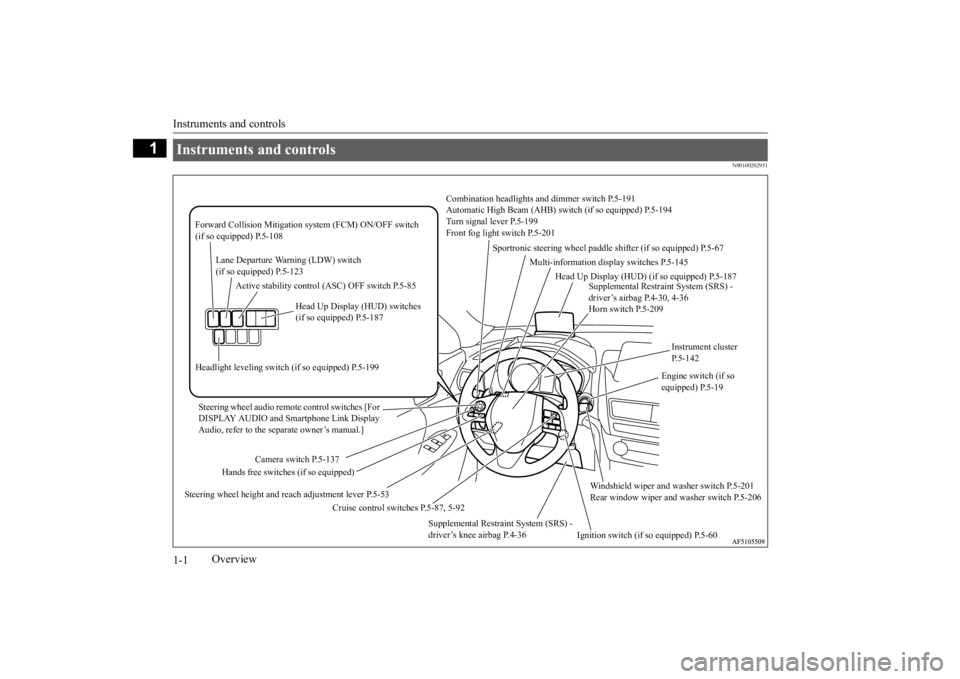
Instruments and controls 1-1
1
Overview
N00100202951
Instruments and controls
Combination headlights an
d dimmer switch P.5-191
Automatic High Beam (AHB) sw
itch (if so equipped) P.5-194
Turn signal lever P.5-199 Front fog light switch P.5-201
Steering wheel audio remote control switches [For DISPLAY AUDIO and Smartphone Link Display Audio, refer to the separate owner’s manual.]
Active stability control (ASC) OFF switch P.5-85
Supplemental Restraint System (SRS) - driver’s airbag P.4-30, 4-36Horn switch P.5-209
Instrument cluster P.5-142
Windshield wiper and washer switch P.5-201 Rear window wiper and
washer switch P.5-206
Cruise control switches P.5-87, 5-92
Steering wheel height and reach adjustment lever P.5-53
Engine switch (if so equipped) P.5-19
Sportronic steering wheel paddle
shifter (if so equipped) P.5-67
Lane Departure Warning (LDW) switch (if so equipped) P.5-123
Forward Collision Mitigation
system (FCM) ON/OFF switch
(if so equipped) P.5-108
Supplemental Restraint System (SRS) - driver’s knee airbag P.4-36
Ignition switch (if so equipped) P.5-60
Head Up Display (HUD) switches (if so equipped) P.5-187
Headlight leveling switch
(if so equipped) P.5-199
Camera switch P.5-137
Hands free switches (if so equipped)
Multi-information display switches P.5-145
Head Up Display (HUD)
(if so equipped) P.5-187
BK0277700US.bo
ok 1 ページ 2019年3月8日 金曜日 午前9時23分
Page 6 of 427
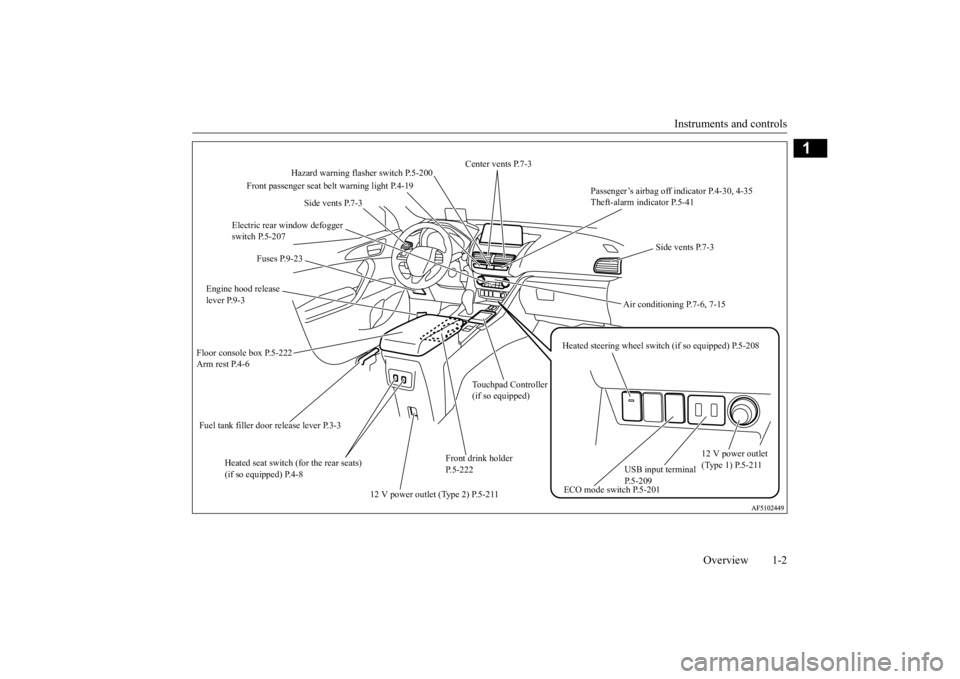
Instruments and controls
Overview 1-2
1
Hazard warning flasher switch P.5-200
Electric rear window defogger switch P.5-207
Fuel tank filler door release lever P.3-3 Engine hood release lever P.9-3 Floor console box P.5-222 Arm rest P.4-6
12 V power outlet (Type 1) P.5-211
Air conditioning P.7-6, 7-15
Passenger’s airbag off indicator P.4-30, 4-35 Theft-alarm indicator P.5-41
Front passenger seat belt warning light P.4-19
Heated steering wheel switc
h (if so equipped) P.5-208
Heated seat switch (for the rear seats) (if so equipped) P.4-8
Side vents P.7-3
ECO mode switch P.5-201
USB input terminal P.5-209
Center vents P.7-3
Fuses P.9-23
Front drink holder P.5-222
Side vents P.7-3
12 V power outlet (Type 2) P.5-211
Touchpad Controller (if so equipped)
BK0277700US.bo
ok 2 ページ 2019年3月8日 金曜日 午前9時23分
Page 15 of 427
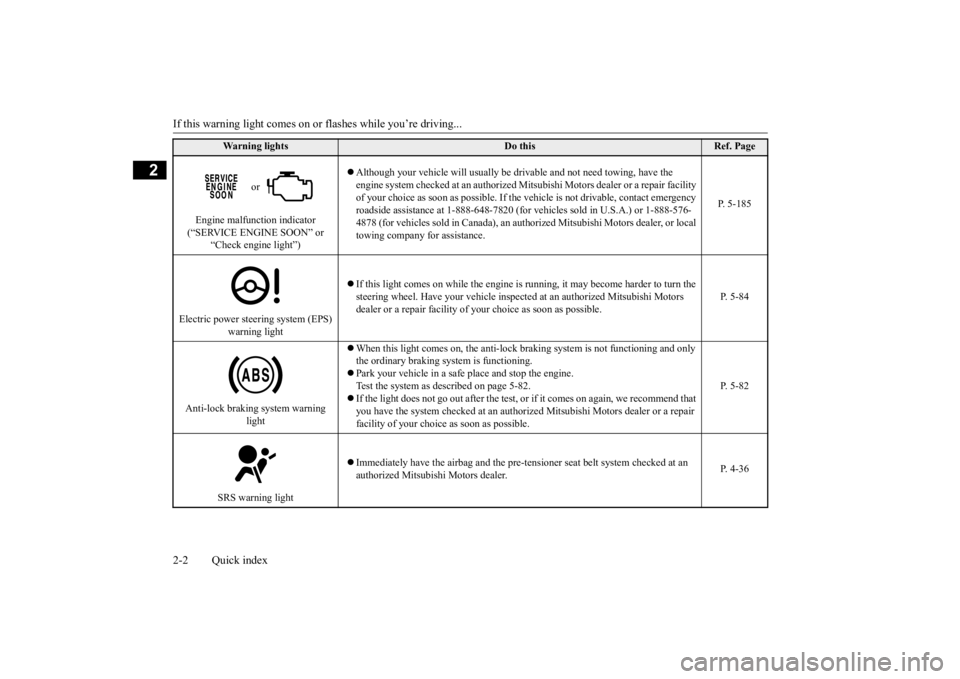
If this warning light comes on or
flashes while you’re driving...
2-2 Quick index
2
or
Engine malfunction indicator (“SERVICE ENGINE SOON” or
“Check engine light”)
Although your vehicle will usually be drivable and not need towing, have the engine system checked at an authorized Mits
ubishi Motors dealer or a repair facility
of your choice as soon as po
ssible. If the vehicle is not
drivable, contact emergency
roadside assistance at 1-888-648-7820 (for ve
hicles sold in U.S.A.) or 1-888-576-
4878 (for vehicles sold in Canada), an author
ized Mitsubishi Motors dealer, or local
towing company for assistance.
P. 5-185
Electric power steering system (EPS)
warning light
If this light comes on while the engine is
running, it may become harder to turn the
steering wheel. Have your vehicle inspected at an authorized Mitsubishi Motors dealer or a repair facility of your choice as soon as possible.
P. 5-84
Anti-lock braking system warning
light
When this light comes on, the anti-lock braking system is not functioning and only the ordinary braking system is functioning. Park your vehicle in a safe place and stop the engine. Test the system as described on page 5-82. If the light does not go out after the test, or if it comes on again, we recommend that you have the system checked at an authorized Mitsubishi Motors dealer or a repair facility of your choice as soon as possible.
P. 5-82
SRS warning light
Immediately have the airbag and the pre-te
nsioner seat belt system checked at an
authorized Mitsubishi Motors dealer.
P. 4-36
Warning lights
Do this
Ref. Page
BK0277700US.bo
ok 2 ページ 2019年3月8日 金曜日 午前9時23分
Page 38 of 427
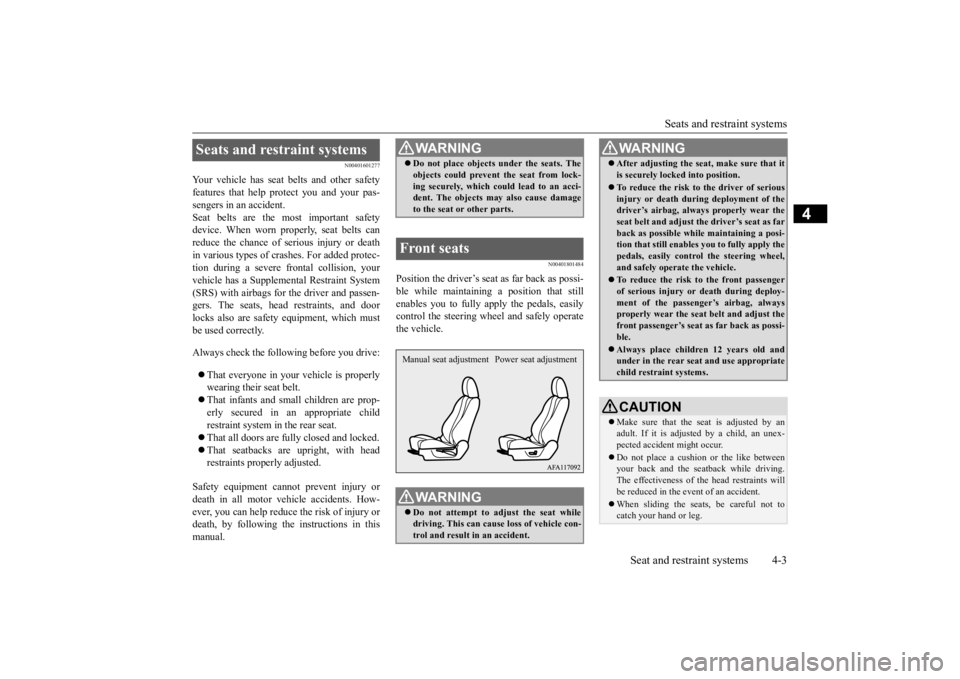
Seats and restraint systems
Seat and restraint systems 4-3
4
N00401601277
Your vehicle has seat belts and other safety features that help protect you and your pas-sengers in an accident. Seat belts are the most important safety device. When worn properly, seat belts canreduce the chance of serious injury or death in various types of crashes. For added protec- tion during a severe frontal collision, yourvehicle has a Supplemental Restraint System(SRS) with airbags for the driver and passen- gers. The seats, head restraints, and door locks also are safety equipment, which mustbe used correctly. Always check the following before you drive: That everyone in your vehicle is properly wearing their seat belt. That infants and small children are prop- erly secured in an appropriate child restraint system in the rear seat. That all doors are fully closed and locked. That seatbacks are upright, with head restraints properly adjusted.
Safety equipment cannot prevent injury or death in all motor vehicle accidents. How-ever, you can help reduce the risk of injury or death, by following the instructions in this manual.
N00401801484
Position the driver’s seat
as far back as possi-
ble while maintaining a position that still enables you to fully apply the pedals, easily control the steering wheel and safely operatethe vehicle.
Seats and restraint systems
WA R N I N G Do not place objects under the seats. The objects could prevent the seat from lock- ing securely, which could lead to an acci- dent. The objects ma
y also cause damage
to the seat or other parts.
Front seats
WA R N I N G Do not attempt to adjust the seat while driving. This can cause loss of vehicle con- trol and result in an accident.Manual seat adjustment Power seat adjustment
After adjusting the seat, make sure that it is securely locked into position. To reduce the risk to the driver of serious injury or death during deployment of thedriver’s airbag, always properly wear the seat belt and adjust th
e driver’s seat as far
back as possible while maintaining a posi-tion that still enables
you to fully apply the
pedals, easily control the steering wheel, and safely operate the vehicle. To reduce the risk to the front passenger of serious injury or death during deploy-ment of the passenger’s airbag, always properly wear the seat belt and adjust the front passenger’s seat as far back as possi-ble. Always place children 12 years old and under in the rear seat and use appropriate child restraint systems.CAUTION Make sure that the seat is adjusted by an adult. If it is adjusted by a child, an unex-pected accident might occur. Do not place a cushion or the like between your back and the seatback while driving. The effectiveness of the head restraints willbe reduced in the event of an accident. When sliding the seats, be careful not to catch your hand or leg.WA R N I N G
BK0277700US.bo
ok 3 ページ 2019年3月8日 金曜日 午前9時23分
Page 49 of 427
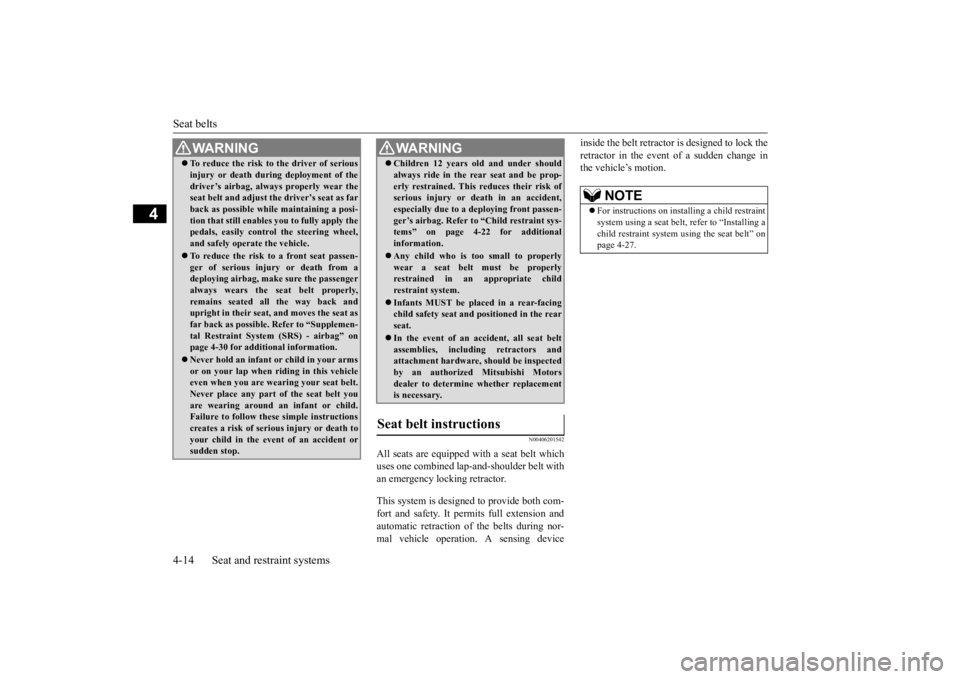
Seat belts 4-14 Seat and restraint systems
4
N00406201542
All seats are equipped with a seat belt which uses one combined lap-and-shoulder belt with an emergency locking retractor. This system is designed to provide both com- fort and safety. It permits full extension and automatic retraction of the belts during nor- mal vehicle operation. A sensing device
inside the belt retractor is designed to lock the retractor in the event of a sudden change in the vehicle’s motion.
To reduce the risk to the driver of serious injury or death during deployment of the driver’s airbag, always properly wear the seat belt and adjust the driver’s seat as far back as possible while maintaining a posi-tion that still enables you to fully apply the pedals, easily control the steering wheel, and safely operate the vehicle. To reduce the risk to a front seat passen- ger of serious injury or death from adeploying airbag, make sure the passenger always wears the seat belt properly, remains seated all the way back andupright in their seat, and moves the seat as far back as possible. Refer to “Supplemen- tal Restraint System (SRS) - airbag” onpage 4-30 for additional information. Never hold an infant or child in your arms or on your lap when riding in this vehicle even when you are wearing your seat belt. Never place any part of the seat belt youare wearing around an infant or child. Failure to follow these simple instructions creates a risk of serious injury or death toyour child in the event of an accident or sudden stop.WA R N I N G
Children 12 years old and under should always ride in the rear seat and be prop- erly restrained. This reduces their risk of serious injury or death in an accident, especially due to a deploying front passen-ger’s airbag. Refer to “Child restraint sys- tems” on page 4-22 for additional information. Any child who is too small to properly wear a seat belt must be properlyrestrained in an appropriate child restraint system. Infants MUST be placed in a rear-facing child safety seat and positioned in the rear seat. In the event of an accident, all seat belt assemblies, including retractors andattachment hardware, should be inspected by an authorized Mitsubishi Motors dealer to determine whether replacementis necessary.
Seat belt instructions
WA R N I N G
NOTE
For instructions on installing a child restraint system using a seat belt, refer to “Installing a child restraint system using the seat belt” on page 4-27.
BK0277700US.bo
ok 14 ページ 2019年3月8日 金曜日 午前9時23分
Page 50 of 427
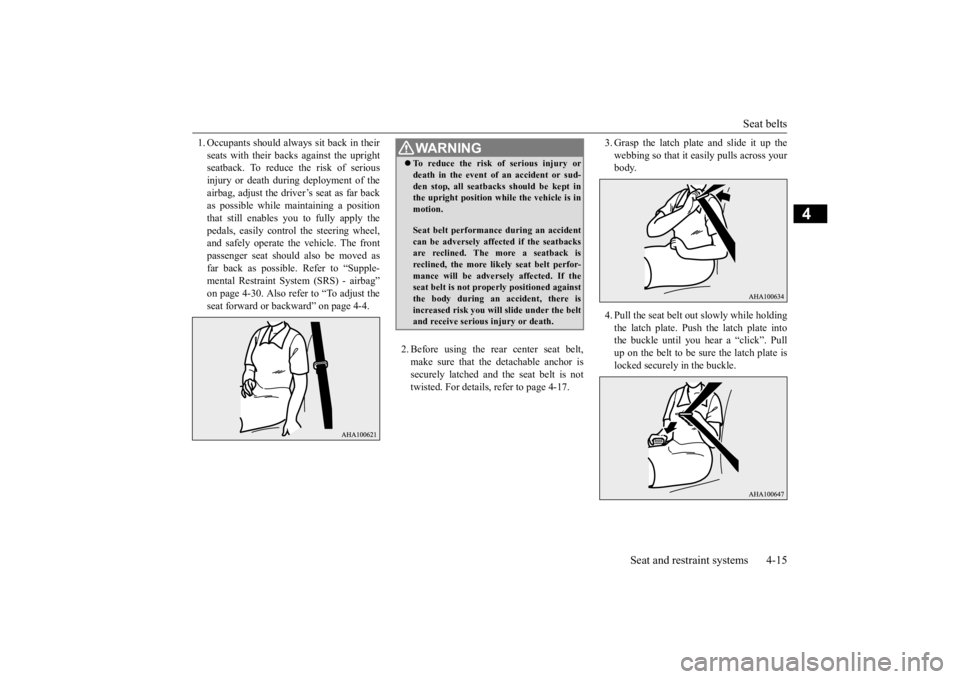
Seat belts
Seat and restraint systems 4-15
4
1. Occupants should always sit back in their seats with their backs against the upright seatback. To reduce the risk of serious injury or death during deployment of theairbag, adjust the driver’s seat as far back as possible while maintaining a position that still enables you to fully apply thepedals, easily control the steering wheel, and safely operate the vehicle. The front passenger seat should also be moved asfar back as possible. Refer to “Supple-mental Restraint System (SRS) - airbag” on page 4-30. Also refer to “To adjust the seat forward or backward” on page 4-4.
2. Before using the rear center seat belt, make sure that the detachable anchor is securely latched and the seat belt is nottwisted. For details, refer to page 4-17.
3. Grasp the latch plate and slide it up the webbing so that it easily pulls across your body. 4. Pull the seat belt out slowly while holding the latch plate. Push the latch plate into the buckle until you hear a “click”. Pull up on the belt to be sure the latch plate islocked securely in the buckle.
WA R N I N G To reduce the risk of serious injury or death in the event of an accident or sud- den stop, all seatbacks should be kept in the upright position while the vehicle is in motion. Seat belt performance during an accident can be adversely affected if the seatbacksare reclined. The more a seatback is reclined, the more likely seat belt perfor- mance will be adversely affected. If theseat belt is not properly positioned against the body during an accident, there is increased risk you will slide under the beltand receive serious injury or death.
BK0277700US.bo
ok 15 ページ 2019年3月8日 金曜日 午前9時23分
Page 66 of 427
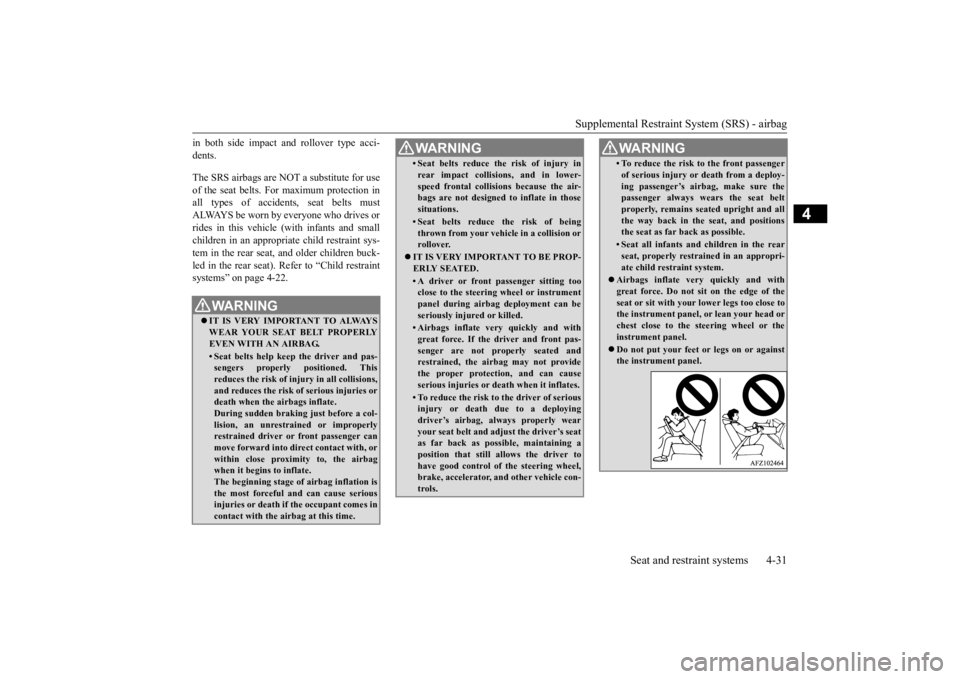
Supplemental Restraint System (SRS) - airbag
Seat and restraint systems 4-31
4
in both side impact and rollover type acci- dents. The SRS airbags are NOT
a substitute for use
of the seat belts. For maximum protection in all types of accidents, seat belts mustALWAYS be worn by everyone who drives or rides in this vehicle (with infants and small children in an appropriate child restraint sys-tem in the rear seat, and older children buck- led in the rear seat). Refer to “Child restraint systems” on page 4-22.
WA R N I N G IT IS VERY IMPORTANT TO ALWAYS WEAR YOUR SEAT BELT PROPERLYEVEN WITH AN AIRBAG.• Seat belts help keep the driver and pas-sengers properly positioned. This reduces the risk of injury in all collisions, and reduces the risk of serious injuries ordeath when the airbags inflate. During sudden braking just before a col- lision, an unrestrained or improperlyrestrained driver or front passenger can move forward into direct contact with, or within close proximity to, the airbag when it begins to inflate. The beginning stage of airbag inflation isthe most forceful and can cause serious injuries or death if the occupant comes in contact with the airbag at this time.
• Seat belts reduce the risk of injury in rear impact collisions, and in lower- speed frontal collisions because the air- bags are not designed to inflate in those situations.• Seat belts reduce the risk of beingthrown from your vehicle in a collision orrollover.
IT IS VERY IMPORTANT TO BE PROP- ERLY SEATED.• A driver or front passenger sitting tooclose to the steering wheel or instrument panel during airbag deployment can be seriously injured or killed.• Airbags inflate very quickly and withgreat force. If the driver and front pas-senger are not properly seated and restrained, the airbag may not provide the proper protection, and can causeserious injuries or de
ath when it inflates.
• To reduce the risk to the driver of serious injury or death due to a deploying driver’s airbag, always properly wear your seat belt and adjust the driver’s seatas far back as possible, maintaining a position that still allows the driver to have good control of the steering wheel, brake, accelerator, and other vehicle con- trols.WA R N I N G
• To reduce the risk to the front passenger of serious injury or death from a deploy- ing passenger’s airbag, make sure the passenger always wears the seat belt properly, remains seated upright and allthe way back in the seat, and positions the seat as far back as possible.• Seat all infants and children in the rearseat, properly restrained in an appropri- ate child restraint system.
Airbags inflate very quickly and with great force. Do not sit on the edge of theseat or sit with your lower legs too close to the instrument panel, or lean your head or chest close to the steering wheel or theinstrument panel. Do not put your feet or legs on or against the instrument panel.WA R N I N G
BK0277700US.bo
ok 31 ページ 2019年3月8日 金曜日 午前9時23分
Page 71 of 427
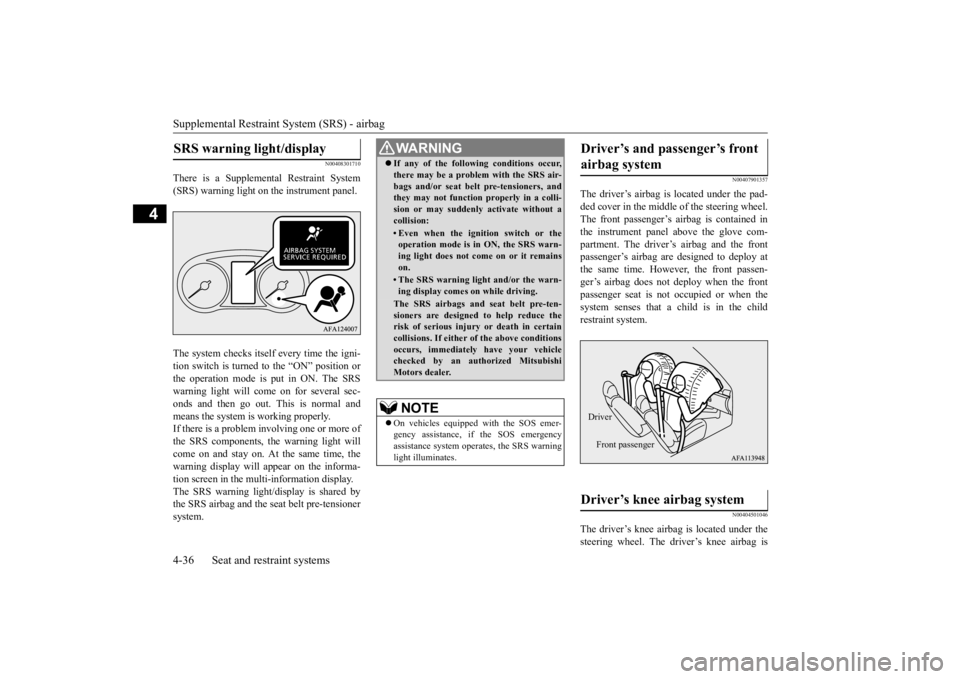
Supplemental Restraint System (SRS) - airbag 4-36 Seat and restraint systems
4
N00408301710
There is a Supplemental Restraint System (SRS) warning light on the instrument panel. The system checks itself every time the igni- tion switch is turned to the “ON” position orthe operation mode is put in ON. The SRSwarning light will come on for several sec- onds and then go out. This is normal and means the system is working properly.If there is a problem involving one or more of the SRS components, the warning light will come on and stay on. At the same time, thewarning display will appear on the informa- tion screen in the multi-information display. The SRS warning light/display is shared bythe SRS airbag and the seat belt pre-tensioner system.
N00407901357
The driver’s airbag is located under the pad- ded cover in the middle of the steering wheel. The front passenger’s airbag is contained in the instrument panel above the glove com-partment. The driver’s airbag and the front passenger’s airbag are designed to deploy at the same time. However,
the front passen-
ger’s airbag does not deploy when the frontpassenger seat is not occupied or when the system senses that a child is in the child restraint system.
N00404501046
The driver’s knee airbag
is located under the
steering wheel. The driver’s knee airbag is
SRS warning light/display
WA R N I N G If any of the following conditions occur, there may be a problem with the SRS air- bags and/or seat belt pre-tensioners, and they may not function properly in a colli- sion or may suddenly activate without acollision:• Even when the ignition switch or theoperation mode is in ON, the SRS warn- ing light does not come on or it remains on.• The SRS warning light and/or the warn-ing display comes on while driving.The SRS airbags and seat belt pre-ten-sioners are designed to help reduce therisk of serious injury or death in certain collisions. If either of the above conditions occurs, immediately have your vehiclechecked by an authorized Mitsubishi Motors dealer.NOTE
On vehicles equipped with the SOS emer- gency assistance, if the SOS emergency assistance system operates, the SRS warning light illuminates.
Driver’s and passenger’s front airbag system Driver’s knee airbag system Driver Front passenger
BK0277700US.bo
ok 36 ページ 2019年3月8日 金曜日 午前9時23分
Page 74 of 427
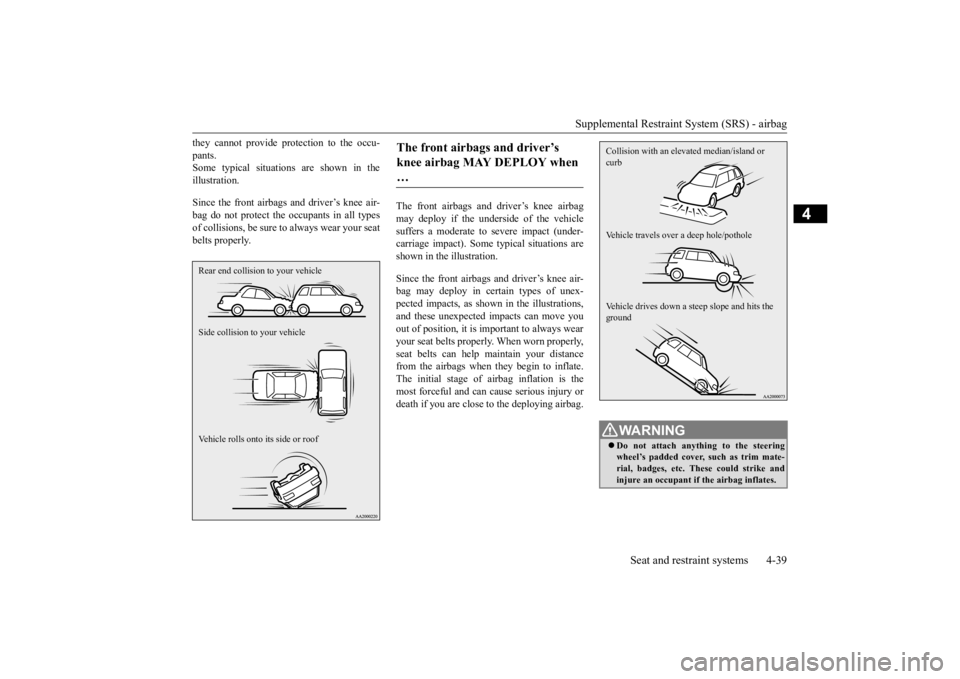
Supplemental Restraint System (SRS) - airbag
Seat and restraint systems 4-39
4
they cannot provide protection to the occu- pants. Some typical situations are shown in the illustration. Since the front airbags and driver’s knee air- bag do not protect the occupants in all types of collisions, be sure to
always wear your seat
belts properly.
The front airbags and driver’s knee airbag may deploy if the underside of the vehicle suffers a moderate to severe impact (under- carriage impact). Some typical situations areshown in the illustration. Since the front airbags and driver’s knee air- bag may deploy in certain types of unex- pected impacts, as shown in the illustrations, and these unexpected impacts can move youout of position, it is important to always wear your seat belts properly. When worn properly, seat belts can help maintain your distancefrom the airbags when they begin to inflate. The initial stage of airbag inflation is the most forceful and can cause serious injury ordeath if you are close
to the deploying airbag.
Rear end collision to your vehicle Side collision to your vehicle Vehicle rolls onto its side or roof
The front airbags and driver’s knee airbag MAY DEPLOY when …
WA R N I N G Do not attach anything to the steering wheel’s padded cover, such as trim mate-rial, badges, etc. These could strike and injure an occupant if the airbag inflates.Collision with an elevated median/island or curb Vehicle travels over a deep hole/pothole Vehicle drives down a steep slope and hits the ground
BK0277700US.bo
ok 39 ページ 2019年3月8日 金曜日 午前9時23分
Page 79 of 427
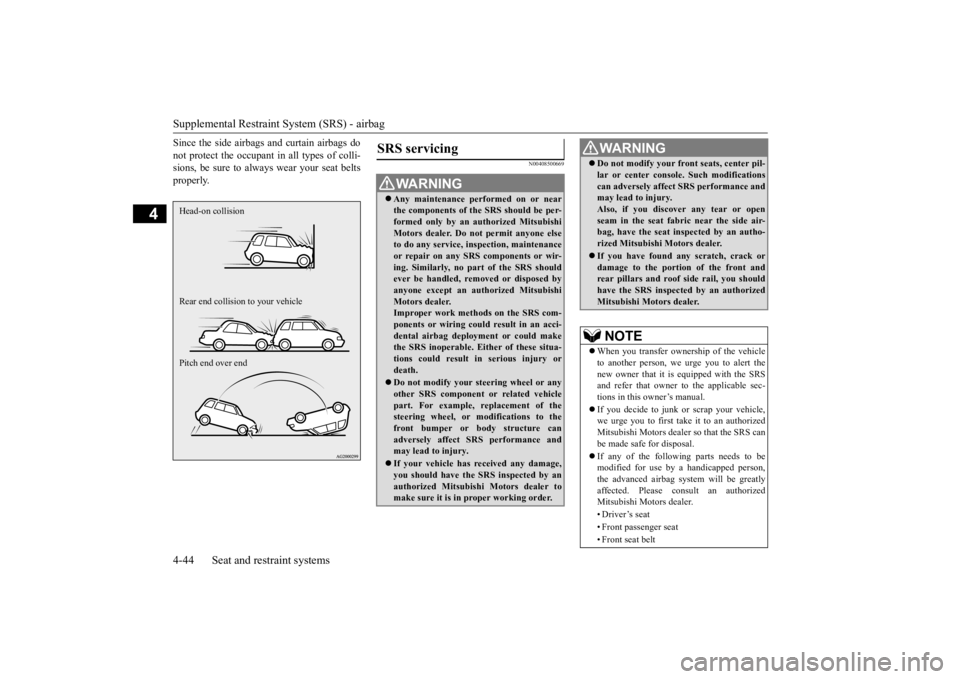
Supplemental Restraint System (SRS) - airbag 4-44 Seat and restraint systems
4
Since the side airbags and curtain airbags do not protect the occupant in all types of colli- sions, be sure to always wear your seat belts properly.
N00408500669
Head-on collision Rear end collision to your vehicle Pitch end over end
SRS servicing
WA R N I N G Any maintenance performed on or near the components of the SRS should be per- formed only by an authorized Mitsubishi Motors dealer. Do not permit anyone elseto do any service, inspection, maintenance or repair on any SRS components or wir- ing. Similarly, no part of the SRS shouldever be handled, removed or disposed by anyone except an authorized Mitsubishi Motors dealer.Improper work methods on the SRS com- ponents or wiring could result in an acci- dental airbag deployment or could makethe SRS inoperable. Either of these situa- tions could result in serious injury or death. Do not modify your steering wheel or any other SRS component or related vehiclepart. For example, replacement of the steering wheel, or modifications to the front bumper or body structure canadversely affect SRS performance and may lead to injury. If your vehicle has received any damage, you should have the SRS inspected by an authorized Mitsubishi Motors dealer to make sure it is in proper working order.
Do not modify your front seats, center pil- lar or center console. Such modifications can adversely affect SRS performance and may lead to injury. Also, if you discover any tear or openseam in the seat fabric near the side air- bag, have the seat inspected by an autho- rized Mitsubishi Motors dealer. If you have found any scratch, crack or damage to the portion of the front andrear pillars and roof side rail, you should have the SRS inspected by an authorized Mitsubishi Motors dealer.NOTE
When you transfer ownership of the vehicle to another person, we urge you to alert the new owner that it is equipped with the SRS and refer that owner to the applicable sec-tions in this owner’s manual. If you decide to junk or scrap your vehicle, we urge you to first take
it to an authorized
Mitsubishi Motors dealer so that the SRS can be made safe for disposal. If any of the following parts needs to be modified for use by a handicapped person, the advanced airbag system will be greatly affected. Please consult an authorizedMitsubishi Motors dealer. • Driver’s seat• Front passenger seat • Front seat beltWA R N I N G
BK0277700US.bo
ok 44 ページ 2019年3月8日 金曜日 午前9時23分